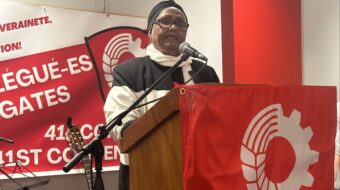A group of Japanese atomic bomb survivors (Hibakusha) visited the National Air and Space Museum, a branch of the Smithsonian Institution, in Washington, D.C., on Dec. 12 to request that the museum’s planned exhibit of the Enola Gay, the B-29 bomber that dropped the atomic bomb on the Japanese city of Hiroshima in 1945, bear a label describing the damage caused by the atomic bombing and the agony of the Hibakusha.
The seven-member delegation of the Japan Confederation of A and H Bomb Sufferers’ Organizations (Japan Hidankyo), led by Tanaka Terumi, Hidankyo secretary-general, handed thousands of signatures in support of their demand to the museum’s director.
With these signatures, Hidankyo called on President George W. Bush and Gen. J.R. “Jack” Dailey, the director of the National Air and Space Museum, to “include in the exhibition photographs and other materials showing the damage and aftereffects of the bombing, or cancel the exhibition.”
The restored Enola Gay, the U.S. bomber that made the world’s first atomic attack on August 6, 1945, went on public display on Dec. 15 at a new annex of the U.S. National Air and Space Museum outside Washington, D.C., in defiance of strong public protests against the way it is exhibited.
Insisting that the Enola Gay will go on display as an example of “technological achievement,” the Smithsonian museum has made clear that there will be no explanation of the damage and aftereffects of the atomic bombing of Hiroshima. (See related article, page 14.)
– Japan Press Weekly









